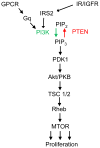Good news for the ageing beta cell
- PMID: 24257895
- PMCID: PMC3900498
- DOI: 10.1007/s00125-013-3114-7
Good news for the ageing beta cell
Conflict of interest statement
The authors declare that there is no duality of interest associated with this manuscript.
Figures

Comment on
-
Adult-onset deletion of Pten increases islet mass and beta cell proliferation in mice.Diabetologia. 2014 Feb;57(2):352-61. doi: 10.1007/s00125-013-3085-8. Epub 2013 Oct 26. Diabetologia. 2014. PMID: 24162585 Free PMC article.
Similar articles
-
Adult-onset deletion of Pten increases islet mass and beta cell proliferation in mice.Diabetologia. 2014 Feb;57(2):352-61. doi: 10.1007/s00125-013-3085-8. Epub 2013 Oct 26. Diabetologia. 2014. PMID: 24162585 Free PMC article.
-
Selective deletion of Pten in pancreatic beta cells leads to increased islet mass and resistance to STZ-induced diabetes.Mol Cell Biol. 2006 Apr;26(7):2772-81. doi: 10.1128/MCB.26.7.2772-2781.2006. Mol Cell Biol. 2006. PMID: 16537919 Free PMC article.
-
PTEN controls β-cell regeneration in aged mice by regulating cell cycle inhibitor p16ink4a.Aging Cell. 2013 Dec;12(6):1000-11. doi: 10.1111/acel.12132. Epub 2013 Aug 6. Aging Cell. 2013. PMID: 23826727 Free PMC article.
-
β-Cell Ca(2+) dynamics and function are compromised in aging.Adv Biol Regul. 2015 Jan;57:112-9. doi: 10.1016/j.jbior.2014.09.005. Epub 2014 Sep 20. Adv Biol Regul. 2015. PMID: 25282681 Review.
-
Functional changes in beta cells during ageing and senescence.Diabetologia. 2020 Oct;63(10):2022-2029. doi: 10.1007/s00125-020-05185-6. Epub 2020 Sep 7. Diabetologia. 2020. PMID: 32894312 Free PMC article. Review.
Cited by
-
A 3D map of the islet routes throughout the healthy human pancreas.Sci Rep. 2015 Sep 29;5:14634. doi: 10.1038/srep14634. Sci Rep. 2015. PMID: 26417671 Free PMC article.
-
Na+/Ca2+ Exchanger a Druggable Target to Promote β-Cell Proliferation and Function.J Endocr Soc. 2018 May 25;2(7):631-645. doi: 10.1210/js.2017-00370. eCollection 2018 Jul 1. J Endocr Soc. 2018. PMID: 29942927 Free PMC article.
References
-
- Teta M, Long SY, Wartschow LM, Rankin MM, Kushner JA. Very slow turnover of beta-cells in aged adult mice. Diabetes. 2005;54:2557–2567. - PubMed
-
- Kassem SA, Ariel I, Thornton PS, Scheimberg I, Glaser B. Beta cell proliferation and apoptosis in the developing normal human pancreas and in hyperinsulinism of infancy. Diabetes. 2000;49:1325–1333. - PubMed
Publication types
MeSH terms
Substances
Grants and funding
LinkOut - more resources
Full Text Sources
Other Literature Sources
Medical

